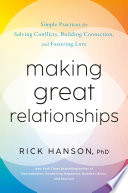

Trust is the cornerstone of any great relationship. It is built over time through consistent actions and open communication. The book emphasizes that trust must be mutual; both parties need to feel secure and valued. Trust can be easily broken, and once it is, it takes considerable effort to rebuild. The authors provide practical steps to foster trust, such as being transparent, keeping promises, and showing vulnerability. They also discuss the importance of empathy and understanding in reinforcing trust, highlighting that great relationships thrive when both individuals prioritize each other's feelings and perspectives.
Continue readingCommunication is a critical element in nurturing relationships. The book outlines various communication styles and their impacts on relationships. It stresses the importance of active listening, where one truly engages with what the other person is saying rather than merely waiting for their turn to speak. The authors offer techniques for improving communication, such as asking open-ended questions, providing feedback, and being mindful of non-verbal cues. They also discuss how miscommunication can lead to conflicts and misunderstandings, and provide strategies for resolving these issues constructively.
Continue readingConflicts are inevitable in any relationship, but how they are handled can make or break the bond. The book offers a comprehensive approach to conflict resolution, encouraging readers to view conflicts as opportunities for growth rather than threats. The authors provide a framework for addressing conflicts, which includes identifying the root cause, expressing feelings, and collaboratively seeking solutions. They emphasize the importance of remaining calm and respectful during disagreements, and how practicing forgiveness can lead to stronger relationships. The chapter also includes real-life examples that illustrate effective conflict resolution techniques.
Continue readingVulnerability is often seen as a weakness, but the book argues that it is actually a strength in relationships. By being open and honest about one's feelings and fears, individuals can create deeper connections. The authors discuss how vulnerability fosters intimacy and trust, allowing both parties to feel safe in expressing themselves. They provide exercises to help readers practice vulnerability, such as sharing personal stories and being open about their needs. The book also addresses the fear of rejection that often accompanies vulnerability and offers reassurance that true relationships are built on authenticity.
Continue readingGreat relationships are characterized by mutual support and encouragement. The authors highlight the importance of being each other's cheerleaders and recognizing each other's achievements. They discuss how supportive relationships can lead to personal and professional growth, as individuals feel empowered to pursue their goals. The book provides strategies for fostering a supportive environment, such as celebrating successes together, providing constructive feedback, and being present during challenging times. The authors also emphasize the importance of recognizing when to step back and allow the other person to grow independently.
Continue readingBoundaries are essential for maintaining healthy relationships. The book explains that boundaries are not walls but rather guidelines that help individuals understand each other's limits and needs. The authors discuss the different types of boundaries—emotional, physical, and time—and how to communicate them effectively. They provide examples of how failing to set boundaries can lead to resentment and burnout, while healthy boundaries promote respect and understanding. The chapter includes tips on how to establish and maintain boundaries without causing conflict and how to navigate situations when boundaries are crossed.
Continue readingRelationships require ongoing effort and improvement. The authors encourage readers to regularly assess their relationships and identify areas for growth. They introduce the concept of relationship check-ins, where partners can discuss their feelings, expectations, and any issues that may have arisen. The book emphasizes the importance of being proactive rather than reactive in relationship management. It also discusses how personal growth contributes to relationship health, encouraging individuals to pursue their interests and passions, which in turn enriches their connections with others.
Continue reading